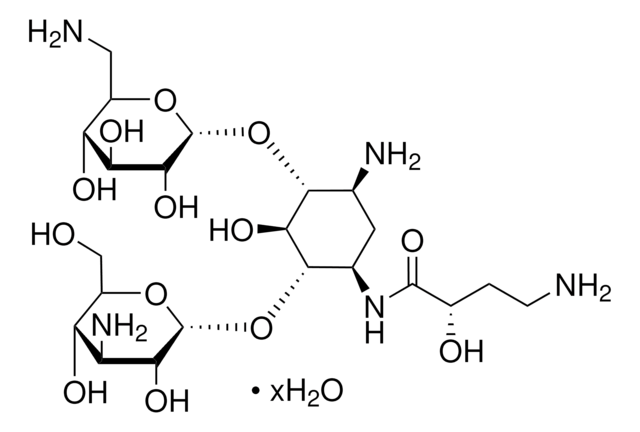K0879
Canamicina sulfate from Streptomyces kanamyceticus
powder, γ-irradiated
Sinónimos:
Canamicina A, Canamicina sulfate salt
About This Item
Productos recomendados
origen biológico
Streptomyces kanamyceticus
grado
Molecular Biology
for molecular biology
esterilidad
γ-irradiated
Formulario
powder
potencia
≥700 μg per mg
color
white to off-white
pH
6.5-8.5(1% solution)
espectro de actividad antibiótica
Gram-negative bacteria
Gram-positive bacteria
mycoplasma
Modo de acción
protein synthesis | interferes
temp. de almacenamiento
2-8°C
idoneidad
nonselective for Escherichia coli
nonselective for coliforms
cadena SMILES
OS(O)(=O)=O.NC[C@H]1O[C@H](O[C@@H]2[C@@H](N)C[C@@H](N)[C@H](O[C@H]3O[C@H](CO)[C@@H](O)[C@H](N)[C@H]3O)[C@H]2O)[C@H](O)[C@@H](O)[C@@H]1O
InChI
1S/C18H36N4O11.H2O4S/c19-2-6-10(25)12(27)13(28)18(30-6)33-16-5(21)1-4(20)15(14(16)29)32-17-11(26)8(22)9(24)7(3-23)31-17;1-5(2,3)4/h4-18,23-29H,1-3,19-22H2;(H2,1,2,3,4)/t4-,5+,6-,7-,8+,9-,10-,11-,12+,13-,14-,15+,16-,17-,18-;/m1./s1
Clave InChI
OOYGSFOGFJDDHP-KMCOLRRFSA-N
¿Está buscando productos similares? Visita Guía de comparación de productos
Descripción general
Aplicación
Acciones bioquímicas o fisiológicas
Modo de resistencia: las enzimas modificadoras de los aminoglucósidos (como la acetiltransferasa, la fosfotransferasa y la nucleotidiltransferasa) pueden alterar este antibiótico y evitar su interacción con los ribosomas.
Espectro antimicrobiano: El sulfato de canamicina es eficaz contra las bacterias gramnegativas y grampositivas, y contra los micoplasmas.
Principio
Nota de preparación
Producto relacionado
Palabra de señalización
Danger
Frases de peligro
Consejos de prudencia
Clasificaciones de peligro
Repr. 1B
Código de clase de almacenamiento
6.1C - Combustible acute toxic Cat.3 / toxic compounds or compounds which causing chronic effects
Clase de riesgo para el agua (WGK)
WGK 2
Equipo de protección personal
Eyeshields, Gloves, type N95 (US)
Elija entre una de las versiones más recientes:
¿Ya tiene este producto?
Encuentre la documentación para los productos que ha comprado recientemente en la Biblioteca de documentos.
Los clientes también vieron
Active Filters
Nuestro equipo de científicos tiene experiencia en todas las áreas de investigación: Ciencias de la vida, Ciencia de los materiales, Síntesis química, Cromatografía, Analítica y muchas otras.
Póngase en contacto con el Servicio técnico








